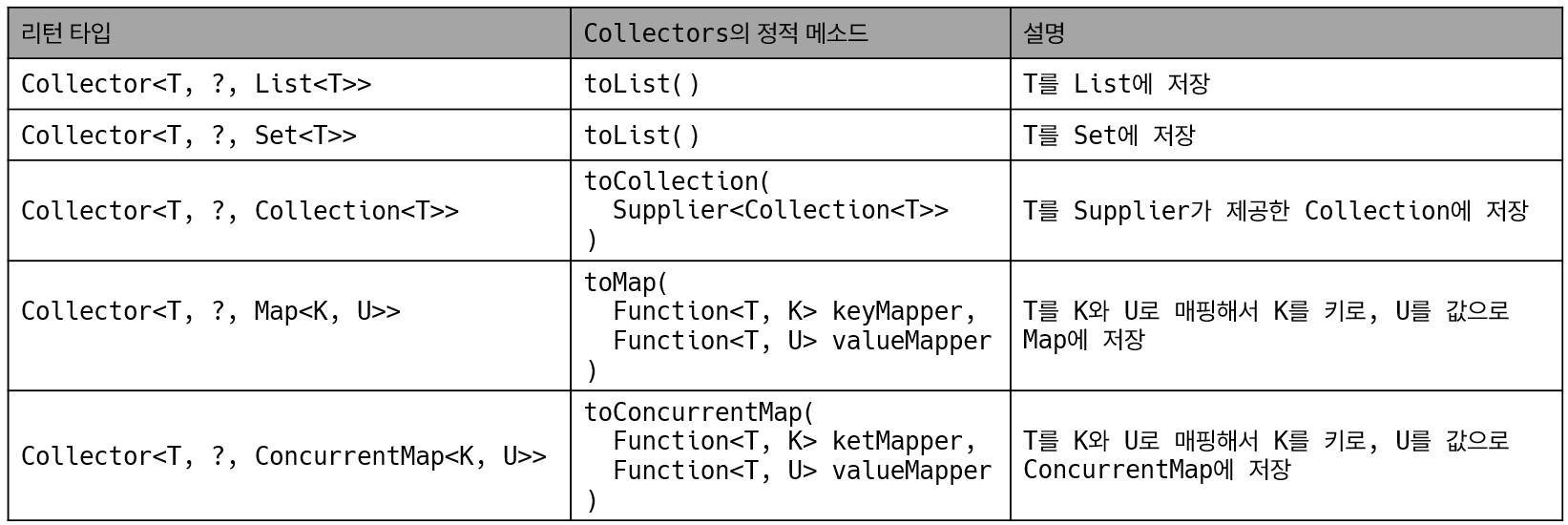[ 수집 (collect()) ]
스트림은 요소들을 필터링 또는 매핑한 후 요소들을 수집하는 최종 처리 메소드인 collect()를 제공하고 있다.
- collect() 메소드를 이용하면 필요한 요소만 컬렉션으로 담을 수 있고, 요소들을 그룹핑한 후 집계(리덕션)할 수 있다.
1. 필터링한 요소 수집
Stream의
collect(Collector<T, A, R> collect)메소드는
필터링 또는 매핑된 요소들을 새로운 컬렉션에 수집하고, 이 컬렉션을 리턴한다.

매개값인 Collector(수집기)는 어떤 요소를 어떤 컬렉션에 수집할 것인지를 결정한다.
Collectors의 타입 파라미터 T는 요소, A는 누적기, R은 요소가 저장될 컬렉션을 의미한다.
즉, Collector<T, A, R>은 요소를 A누적기가 R에 저장한다는 의미이다.
✅ Collector 클래스의 정적 메소드
Collector의 구현 객체는 다음과 같이 Collectors 클래스의 다양한 정적 메소드를 이용해서 얻을 수 있다.

- 리턴값인 Collector의 A(누적기)가
?로 되어 있는 것은 Collector가 R(컬렉션)에 T(요소)를 저장하는 방법을 알고 있어 A(누적기)가 필요 없음을 의미한다. - Map은 스레드에 안전하지 않고, ConcurrentMap은 스레드에 안전하다.
그러므로 멀티 스레드 환경에서 사용하려면 ConcurrentMap을 얻는 것이 좋다.
✅ 예제 | 필터링해서 새로운 컬렉션 생성
전체 학생 리스트 중에서 남학생들만 필터링해서 별도의 List로 생성하고 싶을 때, 다음의 코드를 이용하면 된다.
1. Stream<Student> totalStream = totalList.stream();
2. Stream<Student> maleStream = totalStream.filter(s -> s.getSex() == Student.Sex.MALE);
3. Collector<Student, ?, List<Student>> collector = Collectors.toList();
4. List<Student> maleList = maleStream.collect(collector); - 전체 학생 List에서 Stream을 얻는다.
- 남학생만 필터링해서 Stream을 얻는다.
- List에 Student를 수집하는 Collector를 얻는다.
- Stream에서 collect() 메소드로 Student를 수집해서 새로운 List를 얻는다.
위의 코드에서 변수를 생략하면 다음과 같이 간단하게 작성할 수 있다.
Set<Student> femaleSet = totalList.stream()
.filter(s -> s.getSex() == Student.Sex.FEMALE)
.collect(Collectors.toCollection(HashSet::new));전체 코드
- Student
public class Student {
public enum Sex {MALE, FEMALE}
public enum City {Sedoul, Incheon}
private String name;
private int score;
private Sex sex;
private City city;
public Student(String name, int score, Sex sex) {
this.name = name;
this.score = score;
this.sex = sex;
}
public Student(String name, int score, Sex sex, City city) {
this.name = name;
this.score = score;
this.sex = sex;
this.city = city;
}
public String getName() {
return name;
}
public int getScore() {
return score;
}
public Sex getSex() {
return sex;
}
public City getCity() {
return city;
}
}- ToListExample
import java.util.Arrays;
import java.util.HashSet;
import java.util.List;
import java.util.Set;
import java.util.stream.Collectors;
public class ToListExample {
public static void main(String[] args) {
List<Student> totalList = Arrays.asList(
new Student("김철수", 10, Student.Sex.MALE),
new Student("이영희", 6, Student.Sex.FEMALE),
new Student("박철수", 10, Student.Sex.MALE),
new Student("최영희", 6, Student.Sex.FEMALE)
);
//남학생들만 묶어서 Lit 생성
List<Student> maleList = totalList.stream()
.filter(s -> s.getSex() == Student.Sex.MALE)
.collect(Collectors.toList());
maleList.stream()
.forEach(s -> System.out.println(s.getName()));
System.out.println();
//여학생들만 묶어서 HashSet 생성
Set<Student> femaleSet = totalList.stream()
.filter(s -> s.getSex() == Student.Sex.FEMALE)
.collect(Collectors.toCollection(HashSet::new));
femaleSet.stream()
.forEach(s -> System.out.println(s.getName()));
}
}- 실행 결과
김철수
박철수
이영희
최영희2. 사용자 정의 컨테이너에 수집하기
사용자 정의 컨테이너 객체에 수집하는 방법에 대해 알아보자.
스트림은 요소들을 필터링, 또는 매핑해서 사용자 정의 컨테이너 객체에 수집할 수 있도록 다음과 같이 collect() 메소드를 추가적으로 제공한다.

Supplier는 요소들이 수집될 컨테이너 객체(R)를 생성하는 역할을 한다.- 순차 처리(싱글 스레드) 스트림에서는 단 한 번
Supplier가 실행되고 하나의 컨테이너 객체를 생성한다. - 병렬 처리(멀티 스레드) 스트림에서는 여러 번
Supplier가 실행되고 스레드별로 여러 개의 컨테이너 객체를 생성한다.
하지만 최종적으로 하나의 컨테이너 객체로 결합된다.
- 순차 처리(싱글 스레드) 스트림에서는 단 한 번
XXXConsumer는 컨테이너 객체(R)에 요소(T)를 수집하는 역할을 한다.- 스트림에서 요소를 컨테이너에 수집할 때마다
XXXConsumer가 실행된다.
- 스트림에서 요소를 컨테이너에 수집할 때마다
BiConsumer는 컨테이너 객체(R)를 결합하는 역할을 한다.- 순차 처리 스트림에서는 호출되지 않고, 병렬 처리 스트림에서만 호출되어
스레드별로 객체를 결합해서 최종 컨테이너 객체를 완성한다.
- 순차 처리 스트림에서는 호출되지 않고, 병렬 처리 스트림에서만 호출되어
- 리턴 타입
R은 요소들이 최종 수집된 객체이다.- 순차 처리 스트림에서는 리턴 객체가 첫 번째 Supplier가 생성한 객체지만,
- 병렬 처리 스트림에서는 최종 결합된 컨테이너 객체가 된다.
✅ 순차 처리를 이용해서 사용자 정의 객체에 요소를 수집
학생들 중에서 남학생만 수집하는 MaleStudent 컨테이너가 다음과 같이 정의되어 있다고 가정해보자.
- MaleStudent (남학생이 저장되는 컨테이너)
import java.util.ArrayList;
import java.util.List;
public class MaleStudent {
private List<Student> list; //요소를 저장할 컬렉션
public MaleStudent() {
list = new ArrayList<Student>();
System.out.println("[" + Thread.currentThread().getName() + "] MaleStudent()");
}
public void accumulate(Student student) { //요소를 수집하는 메소드
list.add(student);
System.out.println("[" + Thread.currentThread().getName() + "] accumulate");
}
public void combine(MaleStudent other) { //두 MaleStudent를 결합하는 메소드 (병렬 처리 시에만 호출)
list.addAll(other.getList());
System.out.println("[" + Thread.currentThread().getName() + "] combine()");
}
public List<Student> getList() { //요소가 저장된 컬렉션을 리턴
return list;
}
}
- list 필드는 남학생들이 수집될 필드이다.
스트림에서 읽은 남학생을 MaleStudent에 수집하는 코드는 다음과 같다.
1. Stream<Student> totalStream = totalList.stream();
2. Stream<Student> maleStream = totalStream.filter(s -> s.getSex() == Student.Sex.MALE);
3. Supplier<MaleStudent> supplier = () -> new MaleStudent();
4. BiConsumer<MaleStudent, Student> accumulator = (ms, s) -> ms.accumulate(s);
5. BiConsumer<MaleStudent, MaleStudent> combiner = (ms1, ms2) -> ms1.combine(ms2);
6. MaleStudent maleStudent = maleStream.collect(supplier, accumulator, combiner);- 전체 학생 List에서 Stream을 얻는다.
- 남학생만 필터링해서 Stream을 얻는다.
- MaleStudent를 공급하는 Supplier를 얻는다.
- MaleStudent와 Student를 매개값으로 받아서 MaleStudent의
accumulate()메소드로
Student를 수집하는 BiConsumer 얻는다. - 두 개의 MaleStudent를 매개값으로 받아
combine()메소드로 결합하는 BiConsumer를 얻는다. - supplier가 제공하는 MaleStudent에 accumulator가 Student를 수집해서 최종 처리된 MaleStudent를 얻는다.
참고 | 싱글 스레드에서는 combiner가 사용되지 않는다.
위의 코드에서 변수를 생략하면 다음과 같이 간단하게 작성할 수 있다.
MaleStudent maleStudent = totalSList.stream()
.filter(s -> s.getSex() == Student.Sex.MALE)
.collect(
() -> new MaleStudent(),
(r, t) -> r.accumulate(t),
(r1, r2) -> r1.combine(r2)
);람다식을 메소드 참조로 변경하면 다음과 같이 더욱 간단하게 작성할 수 있다.
MaleStudent maleStudent = totalList.stream()
.filter(s -> s.getSex() == Student.Sex.MALE)
.collect(MaleStudent::new, MaleStudent::accumulate, MaleStudent::combine);✅ 예제 | 순차 스트림 이용해서 MaleStudent에서 남학생 수집
- MaleStudentExample
import java.util.Arrays;
import java.util.List;
public class MaleStudentExample {
public static void main(String[] args) {
List<Student> totalList = Arrays.asList(
new Student("김철수", 10, Student.Sex.MALE),
new Student("이영희", 6, Student.Sex.FEMALE),
new Student("박철수", 10, Student.Sex.MALE),
new Student("최영희", 6, Student.Sex.FEMALE)
);
MaleStudent maleStudent = totalList.stream()
.filter(s -> s.getSex() == Student.Sex.MALE)
.collect(MaleStudent::new, MaleStudent::accumulate, MaleStudent::combine);
maleStudent.getList().stream()
.forEach(s -> System.out.println(s.getName()));
}
}- 실행 결과
[main] MaleStudent()
[main] accumulate
[main] accumulate
김철수
박철수- 실행 결과를 보면 순차 처리를 담당한 스레드는 main 스레드임을 알 수 있다.
MaleStudent()생성자가 딱 한 번 호출되었기 때문에 한 개의 MaleStudent 객체가 생성되었으며,accumulate()는 두 번 호출되었기 때문에 요소들이 2번 수집되었다.
그래서collect()가 리턴한 최종 MaleStudent에는 남학생 두 명이 저장되어 있는 것을 볼 수 있다.

